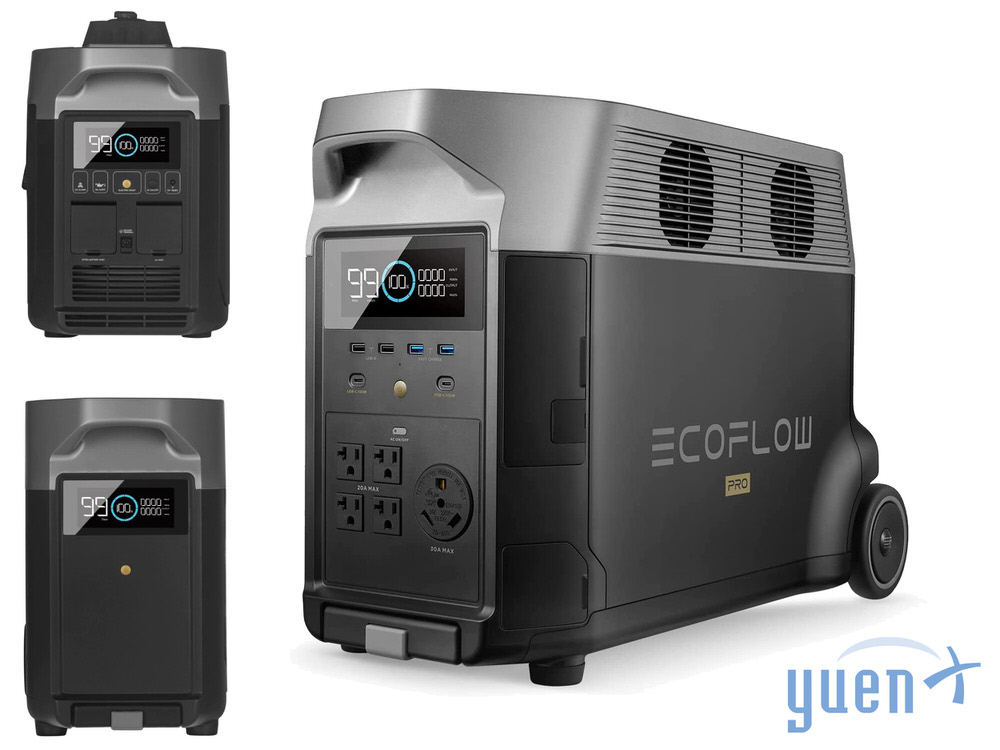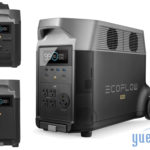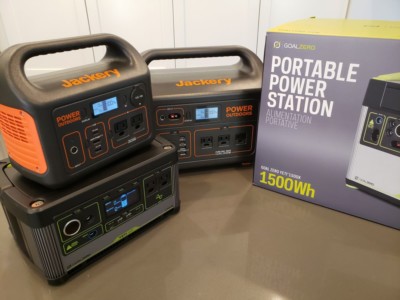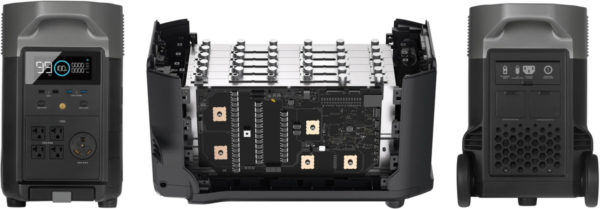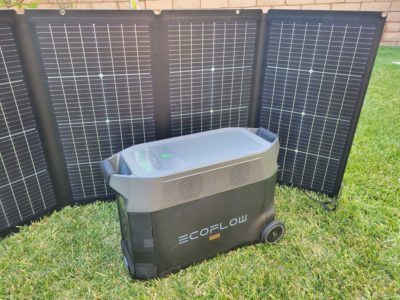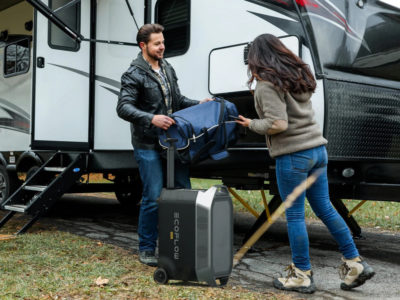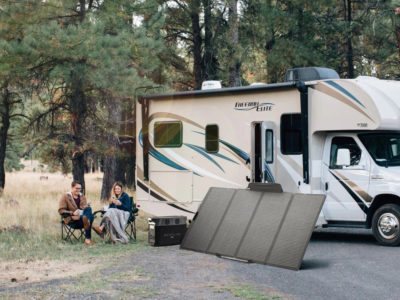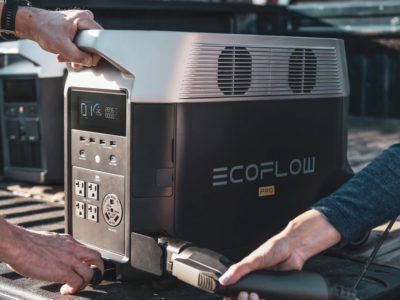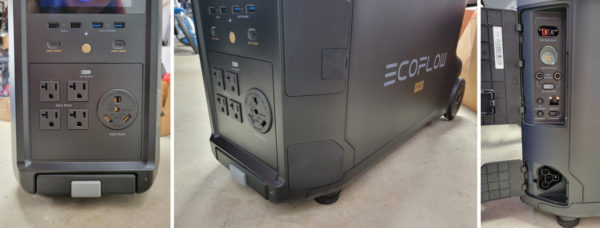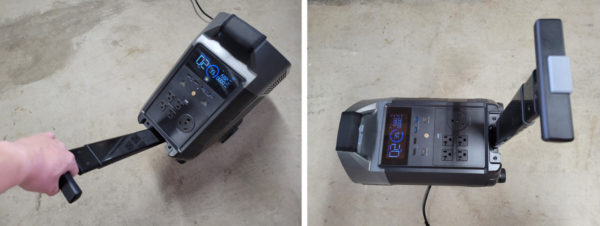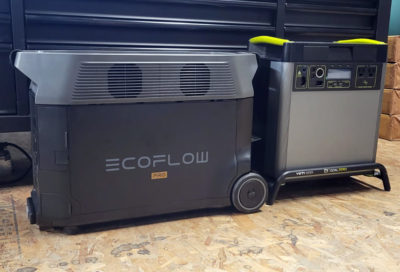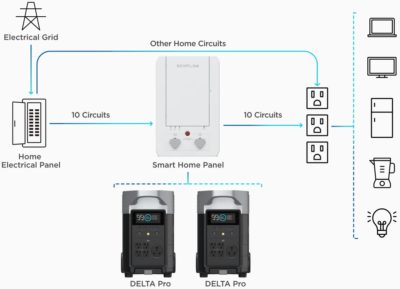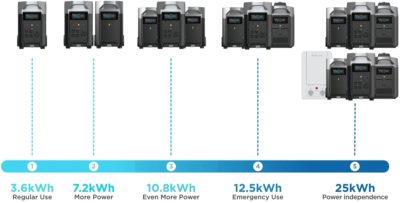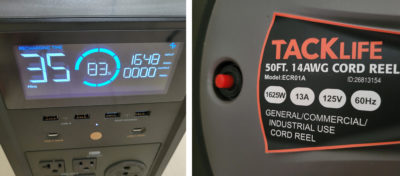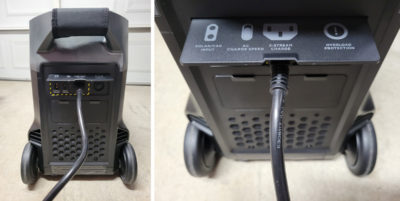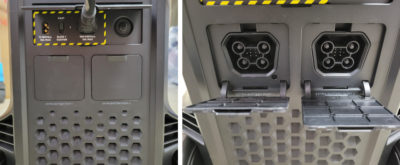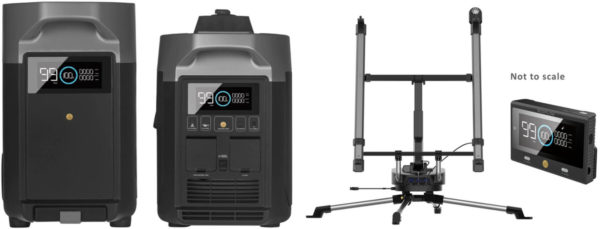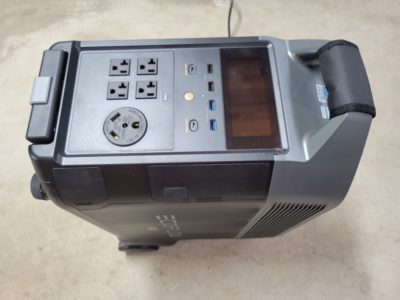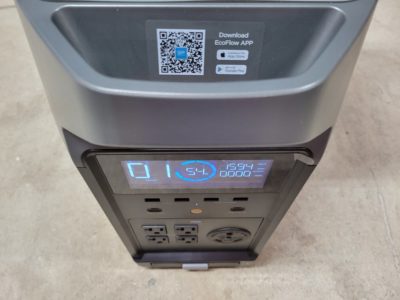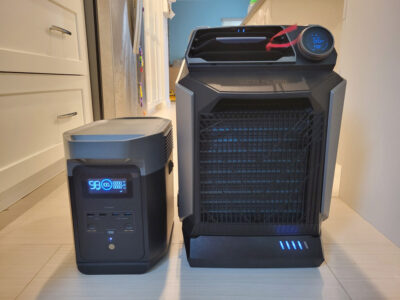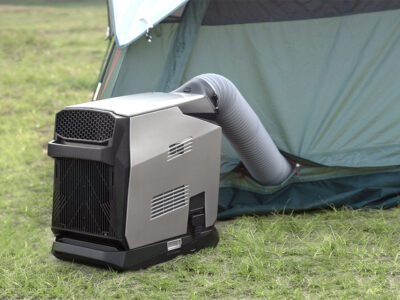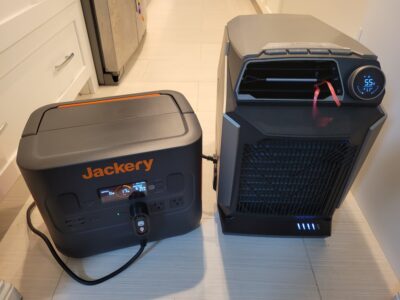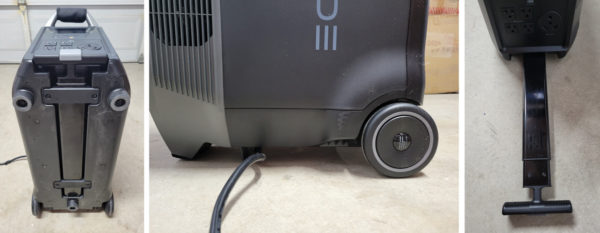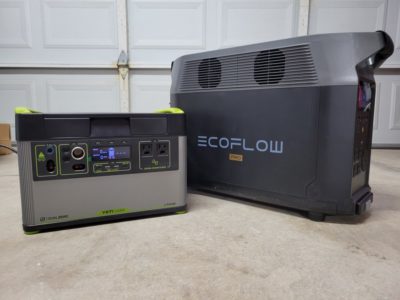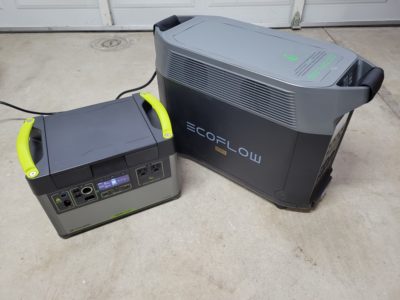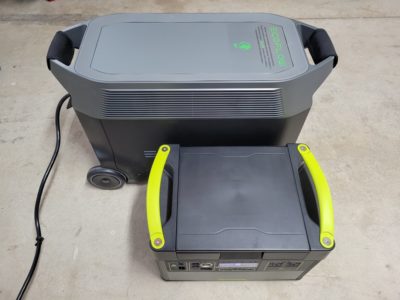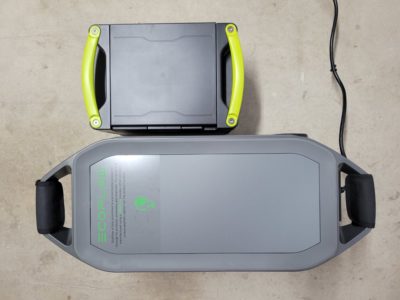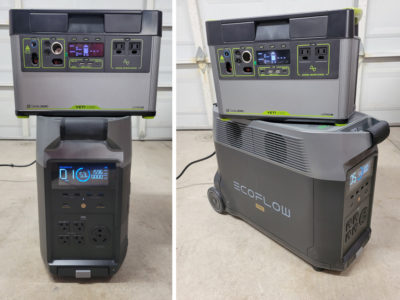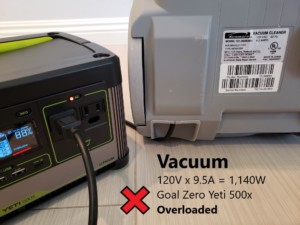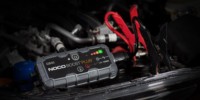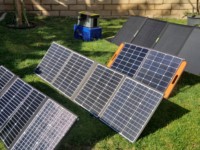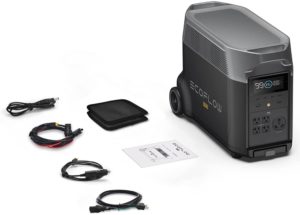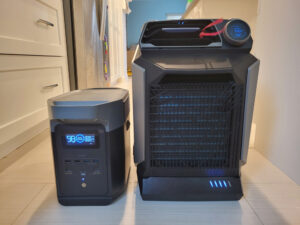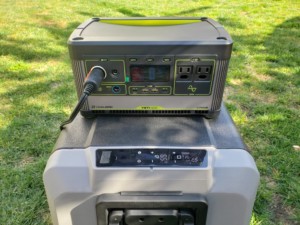EcoFlow DELTA Pro Power Station
Pros
- Highly expandable battery capacity
- LiFePO4 battery chemistry
- Leading AC inverter. Up to 6,500W rapid-charge
- Expansion options with other EF products
- Beautiful, informative smartphone app
Cons
- Very heavy and bulky
- Plastic enclosure
- Wheels too small
- No vehicle integration kit
- Battery not user replaceable
Contents
Shift In Innovation
There had been a notable trend among the power station landscape over the past, few years that had perhaps been fueled by climate change, emergency preparation, looming threat of war, and the COVID-19 pandemic. Where manufacturers had focused on putting out “solar generators” — which really are just battery power stations that could be recharged with solar panels — with ever-increasing specifications that outdoor enthusiasts like me had been drooling over, I have been noticing a shift from the outdoors into the home. For instance, market leader Goal Zero has excellent batteries, solar panels, accessories, and integration kits, but many would be hard pressed to know that their products can also power an entire home or RV.
I have been observing friends and family thinking about having home solar panels installed to reduce their dependence on the local electric utility company, but short of purchasing a large battery from LG or Tesla Powerwall to store excess energy, they would still draw from the electric grid when the sun was not out at night. On the same note, a power outage would ironically also leave a solar-powered home without electricity. Those large LG/Tesla batteries are expensive, can only be installed by professionals, and may need to be replaced every ten years. So, what should you do? I would opt for a portable power station with a home integration kit from Goal Zero. Why? After the initial installation by a qualified electrician, you could modularly replace any end-of-life batteries yourself and even take the main Yeti power station unit camping. Flexibility!
However, a boondocking friend of mine urged me to look at the high-capacity, modular EcoFlow Delta Pro (LiFePO4) battery. I did. And I was amazed by its feature set. I had also come across Jackery’s sister company, Geneverse (formerly Generark), who has the unique-looking HomePower Two (NCM) aimed at homes. Bluetti also has its EP500 (LiFePO4). All of that helped me realize an expanding market geared towards emergency preparation for the homeowner and/or recreational vehicle (RV) enthusiast. Good! Competition is great! Goal Zero, you have some work cut out for you there!
What are the differences? How do they compare to the Jackery Explorer 1000? I am a fan of both Goal Zero and Jackery as both bring their own advantages and disadvantages. Goal Zero and Jackery/Geneverse only had Lithium-ion Nickel Manganese Cobalt (NMC) battery offerings whereas Bluetti, EcoFlow, and BigBlue had Lithium-ion Lithium Iron Phosphate (LiFePO4 / LFP). The latter battery chemistry is less volatile (safer), more usable in extreme temperatures, and has a higher charge cycle count (battery lifetime). I will go over the differences towards the end of this article for those who want to know more.
LiFePO4 batteries are less volatile (safer), more usable in extreme temperatures, and have a higher charge cycle count (battery lifetime) than NMC.
I went for the EcoFlow Delta Pro Power Station and their 220W “Bifacial” Solar Panel (Review) for use with our vacation home merely because their feature sets looked so interesting. This two-part review will first go over the Delta Pro Battery and be followed by the 220W Bifacial Solar Panel.
In A Nutshell
The EcoFlow Delta Pro packs so many features and nuances, it took a surprisingly long time to summarize my thoughts for this review. It is one HECK of a beast of a power station! Although I was not able to test many of the capabilities due to my limited budget, reading and researching about some of the functions kept me in awe.
Goal Zero had been the gold standard for a long time with its market leading quality, safety record, and philanthropy roots, but the Delta Pro definitely should put the company on notice with an ecosystem that surprisingly surpassed Goal Zero’s in many ways. Offering a 3,600Wh battery capacity that could be expanded to 25,000Wh nearly doubles what Goal Zero could currently offer at 15,671Wh, and its AC inverter leapfrogs Goal Zero’s 2,000W of continuous power and 3,500W surge with double that: 3,600W and 7,200W, respectively. What that translates to is more devices and appliances that can be left running for many more days than homes with the Tesla Powerwall or large LG batteries commonly paired with home solar panels.
Sweet Spot: The 1000Wh battery capacity hits the sweet spot for many consumers, including this author, who are looking for the right balance of power and portability. But when it comes to home integration, the more Watt-hours a battery ecosystem offers, the longer one can power a home for during a blackout.
Specifications and numbers aside, the Delta Pro has an impressive set of input (charging) options, including AC wall, EV charger (a first!), solar, DC-producing gas generator, and possibly a wind turbine in the near future. What wowed me was the rapid charging capability when specific EcoFlow products are combined: 6,500W! Goal Zero’s best only charges at 600W, and two years ago, THAT number dropped my jaw. Charging a Delta Pro and Smart Extra Battery (7,200Wh) at 6,500W would take them from empty to full in less than 2 hours — SUPER impressive! Goal Zero’s 600W would have taken over 10 hours.
What additionally sets the Delta Pro apart is its Double Voltage Hub that can double the capacity and output of various Delta Pro product combinations. Tack on the Solar Tracker that uses a top-mounted sensor to follow the sun for maximum exposure, a Smart Generator that uses gasoline to produce DC power to directly feed into the Delta Pro, and you have a good support system to maximize battery capacity to run appliances with for longer, if not infinite, time periods.
A large, colorful display provides information about the battery’s status, and although it is beautiful, it lacks the details that Goal Zero’s higher-end products provide. EcoFlow makes up for that with its gorgeous smartphone app that also tracks historical data to help the owner make a variety of decisions from.
I really like the telescoping, retractable handle built into the EcoFlow: extend it to one of two lengths to tilt the battery backwards, then pull and roll the 99-pound Delta Pro across the house — at least, that’s the theory. Dragging the heavy battery on uneven grounds (like gravel) or traversing stairs is a huge challenge with the Pro’s small wheels. Did you notice the weight I had just mentioned? Ninety-nine pounds is no joke for the average person to carry up a flight of stairs! Goal Zero’s Roll Cart, on the other hand, with its larger wheels conquer those obstacles and surfaces with much more ease.
The EcoFlow tries to shed some of its LiFePO4 battery weight and cost by using a mostly plastic exterior. Although the Delta Pro still looks quite nice, Goal Zero’s Yeti X series is housed in a mostly metallic enclosure that helps dissipate heat and is more durable. Metal withstands impact force better than plastic, no doubt about that, but also adds weight. Two distinctive, exterior design philosophies each with their own pros and cons. Delta Pro is physically larger than the higher-capacity Yeti 6000X (6,071Wh), for some reason.
What surprised me despite all the impressive features of the 3,600Wh Delta Pro, it still costs just a little more than the lower-capacity, 3,032Wh Goal Zero Yeti 3000x. That makes it a great value!
Overall, it both pains and delights me to see the Delta Pro kicking Goal Zero’s Yeti X line to the curb. On one hand, Goal Zero now painfully looks a bit outdated, and on the other hand, Delta Pro has set a new bar that slaps Goal Zero in the face to wake up and innovate. Competition is always good for the consumer, and so, Goal Zero, what will you do next? EcoFlow has a winning product portfolio on its hands that is difficult to beat.
Analysis
As one of Time Magazine’s “Best Inventions of 2021” under the “Sustainability” category, EcoFlow’s Delta Pro power station deservedly turned some heads. It certainly caught my attention with its wide list of features, expansion options, and accessories primarily geared for home use. Market leader, Goal Zero, offers a similar range of products, but EcoFlow does so in a sleeker — and at times more innovative — package. The configuration options gave me some struggles to write about while researching the Delta Pro because there were so MANY, most of which I could not test because it would have cost over $30,400 to collect the entire ecosystem for the “full experience”! Perhaps EcoFlow could sponsor a few items to review someday? (Wink, wink)
Bear with me! There is a LOT to discuss because of EcoFlow’s vast ecosystem of products. I will attempt to summarize the important ones and how they work with the Delta Pro.
Delta Max vs Pro: The Max is a smaller, lighter version of the Pro with less capacity at 2,016 Wh, a smaller AC inverter, and no transport wheels.
Battery Capacity
The Delta Pro offers 3,600 Watt-hours of battery capacity — how long something can run for — that can be expanded with up to two EcoFlow Smart Extra Batteries (3,600 Wh each) for a combined total of 10,800 Wh simply by connecting them with a pair of cables. That could power a typical home drawing 750-1,000W of power per hour for 10-12 hours. Double that to 21,600 Wh by linking another set of Delta Pro and 2 Extra Batteries via either the EcoFlow Smart Home Panel or the Double Voltage Hub. Finally, this can further be expanded to 25,000 Wh through the use of a Smart Home Panel, 2 Delta Pros, 2 Extra Batteries, and 2 EcoFlow Smart Generators — a gas-powered generator that produces virtually unlimited DC output (as long as gasoline is available) for more efficient charging of the Delta Pro.
Goal Zero can only store up to 10,871 Wh with a Yeti 6000X and 4 Yeti Tank Expansion Batteries. Let that sink in. The market leader is actually BEHIND in this area.
EcoFlow’s Smart Home Panel can power up to 10 electrical home circuits during a blackout, the Double Voltage Hub can double the Delta Pro’s capacity with the addition of another unit, and the Smart Generator can provide gas-generated DC power to the Delta Pro for more efficient charging. Furthermore, the generator can directly be controlled by the Delta Pro so it would only be started when needed.
Power Output
Another area the Delta Pro shines at is what devices — and how many of them — it can power at the same time. Its AC inverter can operate at a continuous 3,600W of energy and surge up to 7,200W. If those numbers do not make sense to you, do not worry. I will go over Continuous vs Peak (Surge) in more detail later.
You can throw a number of high-powered devices, like a home air conditioner, refrigerator, TV, laptop, and hair dryer at it with no problem whatsoever as long as their combined power usage does not exceed 3,600W. The Continuous output can be expanded to 4,500W with X-Boost, or 7,200W by combining 2 Delta Pros with either a Smart Home Panel or Double Voltage Hub.
Goal Zero’s flagship Yeti 6000X can only go 2,000W continuously and peak at 3,500W — numbers that were impressive and unheard of when the product was announced in 2020.
Note: Delta Pro will shut off its AC inverter if it detects the wall plug getting overloaded when used in pass-through (UPS) mode. Only the battery’s 30A outlet can output 3,600W when disconnected from the AC wall.
Battery Technology
Li-ion: LiFePO4 vs NMC
There had been a lot of debate over whether Nickel Manganese Cobalt (NMC) or Lithium Iron Phosphate (LiFePO4) was better. Both are Lithium-ion batteries. Goal Zero, Jackery, and most of today’s power station manufacturers use NMC, but why do EcoFlow and Bluetti use LiFePO4 when they are bulkier and heavier? There are important distinctions, but the best battery is the one that meets all or most of your unique needs.
Charge Cycles
One of the most significant differences — and buying factors — is the charge cycle count for both battery chemistries. It measures how long the battery can be used for before it must be replaced or thrown away. LiFePO4’s count is as high as 4,000 cycles (as of 2023) whereas NMC is 500+. However, both have a useful life that can range between 3,000 – 5,000 cycles (even as much as 7,000 with proper care). But how does the count determine longevity?
Let’s look at Li-ion NMC as an example. It loses about 20-25% of total capacity after every 500 charge cycle. That means after the first 500 cycles, the battery drops 20% from when it was new, then another 20% after the next 500 cycles, and 20% again after that one. It would take roughly 1,500 charging cycles to have the battery last only half as long as when it was brand-new. Thus, it should be usable for 2,000+ cycles or about 6-10 years. Li-ion LiFePO4 can last longer.
CAUTION: Lithium-ion (LiFePO4 and NMC) batteries do NOT like to remain discharged at 0% for prolonged periods of time. If you let your battery stay at 0% for too long, you may not be able to charge it again without specialized equipment. Keep them at between 20-80% while in storage to maximize their lifetime.
LiFePO4 Advantages
- Safer, less volatile, and thus cheaper to manufacture
- Higher charge cycle: 1500-2000 (10+ years). NMC: 500+ (6-10 years)
- Usable in more extreme temperatures (-4F/-20C to 176F/80C). NMC: only 140F/60C max
- Holds 350-day charge. NMC: 300
NMC Advantages
- Smaller and lighter. Allows for more portable products
- Faster charging
Input (Charging) Options
Get yourself some popcorn for this. There are over a handful of ways to charge the Delta Pro, one of which provides 6,500W of input and prompted EcoFlow to claim the “World’s Fastest Charging” power station title.
- AC
- Wall: 1,800W (120V @ 15A) or 3,000W (240V @ 12.5A)
- No power brick — 14AWG cord plugs directly from the wall to the battery
- Never, ever use an extension cord to charge with! It could cause a fire or trip the circuit breaker at best
- EV Charger: 3,400W (with EcoFlow EV X-Stream Adapter)
- Charge to 100% at level 2 AC EV charging stations (with Type 1 J1772 or Type 2 Mennekes connector types) in 1.7 hours, according to the manufacturer
- EcoFlow Smart Home Panel: 3,400W
- Provides up to 10 home circuits with power within 20ms of a blackout
- Wall: 1,800W (120V @ 15A) or 3,000W (240V @ 12.5A)
- Solar (XT60 port): 1,600W (11-150V @ 15A)
- Uses MPPT that is much more efficient for charging than the older PWM technology
- Any combination of most solar panel brands and number of panels can be used as long as their combined voltage and current do not exceed 11-150V and 15A
- Connect up to 3 in series — or 2 sets of 3 (in series) for a total of 6 in parallel. Keep open-circuit voltage at 10-65V
- MC4-to-XT60 cable is included (11.5′ / 3.5m)
- EcoFlow Solar Tracker can auto-track the sun’s position for maximum charging
- EcoFlow Smart Generator (Gas): 1,800W (up to 5,400Wh on a full tank)
- Generator can be used standalone or with Delta Pro with included Smart Generator Adapter
- EcoFlow Wind Turbine — Unavailable at the time of this writing
- I had asked Goal Zero and Jackery for this option for years!
- Car Cigarette Port: 96W (12V @ 8A) or 192W (24V @ 8A)
- Rooftop Solar support is coming
Tip: A record-breaking input of 6,500W (!) can be achieved by combining AC + Solar + Smart Generator charging! (A Smart Extra Battery must be connected to the Delta Pro for this to work.)
AC Charging Speeds
The back of the Delta Pro has a toggle for how much power it should draw for charging: Fast or Slow/Custom.
- Fast: 1,800W (120V @ 15A) or 3,000W (240V @ 12.5A)
- 0-80% in 2 hours and to 100% after another 45 mins
- Slow/Custom: 200W – 1,800W
- Slow charging is gentler on the battery, prolongs its lifetime, and minimizes risk of tripping the circuit breaker
- Custom allows the Delta to charge at a configured rate so the wall circuit would not be overloaded. That’s an EXCELLENT feature to have!
- Example: If an AC Circuit can only handle 1,200W and a coffee maker uses 800W, then the Delta Pro should be configured to charge at no more than 400W (1,200W – 800W)
- Configurable through the EcoFlow app
Tip: AC charging is prioritized over DC when both are connected simultaneously. Never use an extension cord to charge the Delta Pro with unless it’s a heavy-duty one.
Output Options
- AC with 3,600W continuous and 7,200W peak
- (4) 20A
- (1) NEMA 30A for RV hookup (3 prongs = 30A, 4 prongs = 50A)
If the Delta Pro is used in pass-through UPS (uninterruptible power supply) mode, the internal circuit will turn off its inverter if it detects the AC wall outlet getting overloaded (ie. passing through more than 20A). This means that it could shut off at 1,200W without ever reaching its 3,600W capacity. To use the full 3,600W, disconnect it from the wall and let the battery provide that power.
Note: Using a battery as a UPS (charging and outputting at the same time) could shorten its lifetime.
- DC
- (2) USB-A (12W max, 5V @ 2.4A)
- (2) USB-A Fast Charge (18W max)
- (2) USB-C (100W max, 5/9/12/15/20V @ 5A)
- Could charge two high-powered laptops at the same time
- (2) DC5521 (5.5mm x 2.1mm barrel) (38W max, 12.6V @ 3A)
- A common use for this port is to connect a DC5521-to-Car Cigarette Port adapter so another car freezer, for example, could be connected
- (1) Car Cigarette Port (126W max, 12.6V @ 10A)
- Anderson Power Pole (APP) port (378W max, 12.6V @ 30A)
- Vertically configured like Goal Zero’s HPP, but in reverse
- Remote port
- Connect an EcoFlow Remote Control unit via an Ethernet network cable for monitoring and controlling the Delta Pro from afar. This allows the battery to be tucked away from view
Portable Air Conditioner
The EcoFlow Wave is a portable air conditioner that accepts both AC and DC input. The company, of course, recommends using its own Delta power stations for better efficiency and longer runtime because they can draw directly from DC power. In a pinch, any battery or generator capable of providing the Wave-required input wattage could be used, but keep in mind that AC power loses some energy due to conversion to DC.
What’s Good? What’s Bad?
Pros
- Impressive battery capacity (3,600Wh – 25,000Wh)
- Superfast, configurable charging speeds (200W – 1,800W or up to 6,500W under specific conditions!)
- Li-ion LiFePO4 battery chemistry provides 10+ years of power
- Up to 2,000 – 3,000 cycles based on my research (I do not believe EcoFlow’s claim of lasting much longer than 6,500 cycles. Hope they prove me wrong 15-20 years from now!)
- Much safer and stable than Li-ion NMC
- Large AC inverter with continuous 3,600W (7,200W peak) of output
- Enough to power a typical home for days — or, when used with the EcoFlow (Gas) Smart Generator and/or set of solar panels, virtually forever
- Pure-Sine Wave AC Inverter
- Clean power for sensitive electronics
- Less heat
- Note: Some manufacturers claim to be Pure-Sine when they are actually Modified or Square Waves
- High-quality BMS (Battery Management System) for safety
- Provides built-in overload, overcharge (automatic stop when the device is full), and short-circuit protection
- Expansion/augmentation ecosystem with EF Solar Panels, Double Voltage Hub, Smart Generator, Extra Smart Batteries, Smart Home Panel, wind turbine (not yet available), EV charging station, and Remote Control
Tip: It is possible to get multiple companies’ products (battery power stations and solar panels) to work with one another once you understand the different connector types, such as Anderson APP, MC4, 8mm, and so on. In one test, I had simultaneously connected solar panels by Goal Zero, Jackery, Suaoki, and Paxcess to the Yeti 1500x’s Anderson port to collect energy from all four! Although I did not test this with the Delta Pro, it should work the same way.
- Impressive input and output options, including a NEMA 30A for RV hookup
- Up to 1,600W of solar charging
- Carry handle is strong enough to run a cable lock through for theft deterrence
- Can be used in pass-through UPS mode, though that can shorten the battery’s lifetime
- Beautiful, large, color information display
- Built-in, retractable handle
- Wheels for easier transportation
- Strong Research & Development and Engineering teams who create innovations that Goal Zero, Jackery/Geneverse, and Bluetti cannot ignore
- Competition hopefully continues to spur better products from all companies
- Beautiful, informative EcoFlow smartphone app with historical data (for Apple iOS and Android)
Cons
- Heaviest power station (99 lbs) I have ever reviewed
- Weight is due to the use of 3,600Wh of LiFePO4 battery cells instead of NMC
- Comparison: Goal Zero, despite using a more heavy-duty, metallic enclosure, has the Yeti 3000X (3,032Wh) weigh at 70lbs, Yeti 6000X (6,071Wh) at 106 lbs
- Difficult to move up stairs, lifting onto truck bed, or pulling across gravel ground — especially with the small wheels
- Weight is due to the use of 3,600Wh of LiFePO4 battery cells instead of NMC
- Large at 25″ x 11.2″ x 16.4″
- Even bulkier than Goal Zero’s Yeti 6000x (15.3″ x 10.1″ x 17″) that has 67% more battery capacity. Yeti 3000x is 15.3″ x 10.2″ x 13.6″
- Plastic enclosure helps shed some weight but is not as heavy-duty as Goal Zero’s Yeti X line
- Outputs 3,600W continuously only if powered from its battery and not in a 120V UPS pass-through configuration
- No vehicle integration kit
- Cable to link Delta Pro with additional Smart Batteries is too short, limiting how and where the batteries can be placed
- Car Cigarette Port only accepts 96W of input at 12V
- Goal Zero Yeti X and Jackery Explorer series can take 120W (12V @ 10A)
- Battery not replaceable like the older Goal Zero Yeti 1400 Lithium
- Leads to landfill/environmental waste. Please recycle responsibly!
- Rooftop Solar support not yet available
- Many configuration options are only available through the EcoFlow smartphone app and not from the Delta Pro itself
- Anderson Power Pole (APP) solar part is configured vertically (like Goal Zero, but in reverse)
- Most companies arrange APP horizontally
- Can be remediated by buying an APP extension cable, such as those by iGreely, and re-arranging it
- Manual: Not as detailed and as many helpful tips as Goal Zero’s
- Not an American company
- Not waterproof. Keep it away from water splashes, rain, and pool!
Usage
- Turn off any output ports (AC/DC) that are not being used in order to conserve power
- Without anything plugged in, the AC inverter still draws 7W on its own
- To prolong the battery lifetime while in storage, keep the battery fully charged every 3-6 months
- Or, according to some companies, including Goal Zero, keep it plugged in when not in use and discharge it to 50% every 3-4 months
- The charging controller automatically gets disabled once the battery is full
- You may also charge it to 80% for storage, but be sure to discharge to 20% every 3-4 months
- NOT using the battery for a very long time can actually hurt its lifetime
- There is no “memory effect” in this station’s battery
- Note: It is better to NOT let it completely drain before recharging
- Battery, like all LiFePO4 and NMC, slowly drains over time even when station is powered off
- Could take 1-1.5 years to go from full to empty
- There is no “memory effect” in this station’s battery
- Or, according to some companies, including Goal Zero, keep it plugged in when not in use and discharge it to 50% every 3-4 months
CAUTION: Lithium-ion (LiFePO4 and NMC) batteries do NOT like to remain discharged at 0% for prolonged periods of time. If you let your battery stay at 0% for too long, you may not be able to charge it again without specialized equipment.
Continuous vs Peak Output
It is important to understand the difference between Watts and Watt-Hours. How much power is used or produced is measured in Watts, and how much energy a battery can store is calculated in Watt-Hours. See the “Calculations” section below for more details.
How much energy a battery can store is measured in Wh (Watt-hours), and how much power is used or produced in W (Watts).
- AC Inverter: Converts battery (DC) power into AC
- Delta Pro provides 3,600W continuous output with a 7,200W peak
- Peak/Surge (Starting): Nearly every device initially draws extra power to turn on. The highest amount it pulls is the Peak. As long as that number is below 7,200W, it can be STARTED. Because the Delta Pro’s capacity is so high, it is difficult to provide examples for devices that start at over 7,200W. So, to illustrate the concept, I will use the Goal Zero Yeti 1000 Core’s specs (2,400W peak and 1,200W continuous) as examples.
- Turns on OK (PEAK under 2,400W):
- Freezer starts at 400W (peak), runs at 150W once on
- Coffee maker starts at 1,400W (peak), runs at 800W once on
- Will NOT turn on (PEAK over 2,400W):
- Home AC starts at 4,000W (peak), runs at 1,000W once on
- Turns on OK (PEAK under 2,400W):
Most devices power on at a higher (Peak) wattage than when they are already on (Continuous). Therefore, if its peak exceeds the power station’s max, it may not be able to start
- Continuous Output (Running): Once devices are on, as long as they keep drawing less than 3,600W total, they will stay ON until the battery runs out
- CONTINUES running (under 3,600W)
- 100W TV + 60W laptop = 160W
- COULD STOP running (over 3,600W)
- Temporary overdrawing beyond 3,600W for a few seconds is okay. A quality BMS will protectively shut down the battery if the surge does not end after a while. Regularly going over for a prolonged time can ruin the battery in the long run
- 300W appliance (500W peak) + 1,000W Home AC (4,000W peak) + 800W Coffee maker (1,400W peak) + 1,200W Miter saw (2,400W peak) + 400W appliance = 3,700W. Probably will stay on for a short period
- Add 1,000W mower (1,400W peak) = 4,700W. Battery will definitely shut down
- CONTINUES running (under 3,600W)
Solar Panel – Warning
This power station can be charged with one or more solar panels. There are SOME PRECAUTIONS you must take to minimize battery damage and/or injury to life/property:
- Never exceed the maximum Voltage (V) or Amperage (A) of the power station’s charging port
- Delta Pro limits input to 15A [Thank you, Billy Tanglewood and Kevin Lauzon for the clarification]
- Keep the battery out of direct sunlight while charging. You may have to use an extension cable to keep it in the shade
Wondering what size solar panel to get? See the “Calculations” section below.
Calculations – Size & Time
What size battery should you get? How long will it power your fridge for? How long will it take to recharge? The below calculations can help answer those questions and are rough ESTIMATES as conditions, battery quality, and age can vary.
Time to Charge Battery
- Calc: Hours to charge battery = Battery capacity (Wh) / Input Wattage
- Note: As battery approaches 75% full, the input charge will increasingly be slowed down to prevent overcharging
- AC Wall: 1,800W @ 2 hrs [3,600 Wh / 1,800W]
Charge Time with Solar
- Calc: Hours to charge battery = Battery capacity (Wh) / (Panel Wattage x [0.5 or 0.75])
- In a perfect lab environment, solar panels charge at the listed wattage
- Expect to only receive 50-75% on a good, sunny day (ie. 75W – 113W for a 150W panel), depending on panel’s age, component quality, and weather
- Two 400W solar panels: as fast as 6 hours [3,600Wh / (2 x 400W x 0.75)]
- Tips
- Keep charging even when overcast as the panels will STILL collect energy
- Underproduction: If a 200W panel is not making enough (ie. only 50W) due to bad conditions, adding extra ones (ie. two more 200W) can generate a higher, combined output (ie. 50W + 110W from the two panels = 160W total)
- Overproduction: If the panels make more (ie. 400W) than the maximum the power station charge port can take (ie. 120W), only the max (ie. 120W) will go through
Watts Used/Produced
- Calc: Watts used or produced by device = Voltage x Amperage
- Vacuum with 120V @ 9.5A uses 1,140W
- Solar panel with 12V @ 10A can produce up to 120W
Ideal Battery Size
- Calc: Battery capacity (Wh) = Watts used by device x Hours needed for / 0.85
- 10-15% of power is lost during power conversion
- 45W car fridge needed for 8 hours: Minimum 424Wh power station (45W x 8 / 0.85)
How much energy a battery can store is measured in Wh (Watt-hours), and how much power is used or produced in W (Watts).
Time Before Battery is Empty
- Calc: Hours available for device = Battery capacity (Wh) x 0.85 / Watts used by device
- 10-15% of power is lost during power conversion
- 60W laptop with 505Wh battery: Up to 7.2 hours (505Wh x 0.85 / 60W)
Time to Charge Device
- Calc: Hours to charge device = Device’s battery capacity (Wh) / Input Wattage
- 60W laptop with 200Wh battery: Up to 3.4 hrs (200 Wh / 60W)
Conversion to mAh
- Calc: Powerbank-equivalent capacity (mAh) = Battery capacity (Wh) / Voltage x 1000
- 1 Ah = 1000 mAh
- Goal Zero Yeti 1000 Core @ 3.7V = 265,675 mAh power bank (983 Wh / 3.7V x 1000) or 91,018 mAh @ 10.8V
Tips and Suggestions
Safety
- Always test your devices with the power station before you depend on it on the go
- Unlike NMC that is volatile, LiFePO4 (which the Delta Pro uses) is one of the safest battery technologies available today. Nonetheless…
- To minimize fire damage to your belongings or loved ones, store the power station in the garage and not inside the house. Best storage is a dry, cool place
- You cannot bring a battery of this capacity on a plane
- With the right BMS, quality batteries, and other factors, the power station can be STORED in the car during hot temperatures
- Keep the battery out of direct sunlight. I usually store it on the floor of the car and crack open the windows a tiny bit
- Do not USE any power station in a tightly enclosed area as it can overheat
- Do not USE in the car if temperatures fall below or exceed the battery’s rated, operating temperature
- Car charger: Only use it while the car is RUNNING. Otherwise, you may deplete your car’s battery and leave you stranded
Jump Start Car?
A battery power station like this one cannot be used to jump start a car. Instead, I suggest getting a small, portable one specifically made for that, such as my favorite: NOCO Genius Boost Car Jump Starter (Lithium Battery).
Use With Other Brands
Nearly all of the leading power station manufacturers can be used with competing products or accessories — solar panels in particular.
As long as the panels or different Watt-capacities produce the same VOLTAGE, you will be able to safely use them with the EcoFlow Delta Pro. However, be sure to NOT exceed the power station’s rated input Voltage or Amperage! All you would generally need to interconnect is to buy adapter cables that convert from MC4, 8mm, or other connector types to the Delta Pro’s APP port.
I had previously tested my Goal Zero Yeti 1500x with the company’s own Nomad panel and those by Jackery, Paxcess, and Suaoki. It was a bliss in interconnectivity! What that means is that you can buy lower-priced solar panels that may produce the same capacity as those made by the power station’s manufacturer. You do not always have to buy their own branded products as long as the substitutes stay within the rated limits.
Final Thoughts
Wow, just wow! I am so glad that my boondocking/RV friends recommended me to check out EcoFlow batteries for our vacation home. The Delta Pro opened my eyes and dropped my jaw a number of times during my research with an impressive set of features, capacities, capabilities, and integration options that rival and surpass industry leaders like Goal Zero, Jackery, and Bluetti! The list was so extensive, it took me far too long to try and collect my thoughts and research for this article.
The Delta Pro will hopefully kick the competition in the rear, and force them to innovate and surpass EcoFlow’s latest products with their own. Competition is always good for the consumer, and I cannot wait to see what my favorite companies, Goal Zero and Jackery (and sister company, Geneverse), have cooked up in response!
Related Posts
- Power Generators: Gas vs Propane vs Battery Station (and Solar)
- Ultimate Reference: Power Station Comparison
- EcoFlow Wave Portable Air Conditioner
- Reviews
- EcoFlow 220W Bifacial Solar Panel
- Goal Zero vs Jackery: Yeti 1000 Core vs 1000X vs Explorer 1000
- Goal Zero Yeti 1500x / Yeti 1000x / Yeti 500x
- Jackery Explorer 2000 Pro / Explorer 1000 / Explorer 300
- Bluetti EB70S LiFePO4
- BigBlue Cellpowa500 LiFePO4
- Rockpals 500W / nrgGo 400
- Quick Look
- Announcements
Where To Buy
- EcoFlow
- Delta Power Stations: Pro / Max / Mini
- Delta Pro Smart Extra Battery
- Accessories: Double Voltage Hub / EV X-Stream Adapter
- Smart Home Panel / Smart Generator (Gasoline)
- Solar Panels: 220W “Bifacial” – See our Review / 400W / Other panels
- Delta Power Stations: Pro / Max / Mini
- Solar Panel Cables
- MC4 Extension (EcoFlow | Renogy) / EcoFlow MC4 Parallel Split / iGreely MC4-to-APP / MC4-to-XT60
- Goal Zero
- Geneverse Power Station: HomePower Two (NMC)
- Bluetti Power Station: EP500 (LiFePO4)
- Jackery Explorer Power Stations (NMC): 2000 / 1500 / 1000 – See our Review / 500 / 300 – See our Review
Other Useful Topics
Power Station Comparison
Check it out!
Ultimate Reference: Power Station Comparison – We summarized the specifications of many of the power stations we had come across or reviewed all in one place.
Gas/Propane Generators vs Battery Power Stations
In July 2020, I wrote about this topic after many asked what their differences were. In short, gas/propane generators can run virtually forever but are loud, dirty, and potentially quite dangerous. Battery power stations, on the other hand, are more portable, silent, less volatile, and can be operated indoor, but depend on external power (like solar) to recharge. Where gas/propane are used to GENERATE electricity, batteries STORE them for later use. Personally, I am a fan of the latter because they are so easy to carry around and are safer to use.
Who is EcoFlow (EF)?
EcoFlow was formed in 2017, ten years after Goal Zero had its start. Four years later saw the launch of the Delta Pro series in 2021 that garnered so much widespread attention, it earned one of Time Magazine’s “Best Inventions of 2021” under the “Sustainability” category.
A friend of mine once said that Goal Zero is “the best of the best” because of one simple reason: their vast ecosystem. I did not understand at the time what he meant, but as I learned more about the Yeti 1500x, my eyes were opened. Then EcoFlow came along with the Delta Pro that not only matched, but managed to surpass Goal Zero in many ways with its own collection of products.
Battery Technology and Safety
Goal Zero debuted with Lead-Acid batteries that were bulky and heavy. Today’s devices use Lithium-ion — commonly Nickel Manganese Cobalt (NCM) or Lithium Iron Phosphate (LiFePO4 / LFP) chemistries — for more power in a smaller, lighter package. NMC, however, is more volatile than LiFePO4 and becomes riskier as more cells are packed together. Goal Zero and Jackery used NMC for some time whereas EcoFlow and Bluetti use LiFePO4. Jackery launched its first LiFePO4 model in mid-June 2023 and Goal Zero in October that year.
- How much energy a battery can store is measured in Wh (Watt-hours), and how much power is used or produced in W (Watts)
- The higher the Watt-hour (Wh) capacity rating, the more dangerous the battery could become if not handled right
The quality of the battery cells and the BMS (Battery Management System) are crucial for safety.
Cell Manufacturers
Battery cells made by LG and Sony are among the best in the hobbyist world as are Sanyo/Panasonic and Samsung. Goal Zero uses LG. Jackery also uses LG or BAK (a leading Chinese brand). EcoFlow makes its own. During my years of research, I found that use of lower-quality batteries could pose a serious risk to life and property and should become a crucial part in deciding what to buy.
Safety
The second part in a battery’s safe operation depends heavily on the design and BMS (Battery Management System). Some BMS manufacturers, unfortunately, overstate their capabilities that could lead to catastrophic failure.
- Design should allow for proper, thermal cooling, use quality components, and obtain proper certifications
- Batteries made by known manufacturers are less likely to fail
- BMS should sufficiently restrict the battery from going past its capabilities

